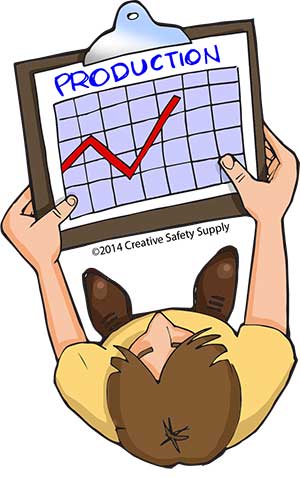
Hoshin Kanri is a term that is often translated as "policy deployment." It is a method for helping to make sure that all the goals of a company are set up to drive progress and action. This applies to every level of a company, which is very important given the common situation where front-line employees feel as if they are doing all the work and high-level executives are doing nothing.
Using this system will help to ensure that everyone is contributing in the way that is intended, and it will also help to ensure that everyone is aware of the roles that other people are playing. When implemented properly, it can have the secondary benefit of easing tensions and improving overall teamwork within just about any company.
Guiding Multiple Areas with One Plan
One of the main benefits of Hoshin Kanri is that it helps to get everyone on the same page in regards to the direction the company is going. A good analogy for this is when ancient ships set sale, each captain would have their compass. This way even though each ship was traveling separately (and would often become separated) they were all operating on the same plan.
By following the compass (or strategic plan) the captains (or executives) could be confident that the entire fleet (company) was moving in a common direction. It is easy to see how this is important for modern businesses, especially as they get bigger and bigger.
Benefits of Hoshin Kanri
- Aligns Organization - Keeping everyone focused on the same goals
- Organization Learns & Improves - Having organized training and improvement opportunities will improve the facility for everyone
- Standardizes Processes - As the facility runs through this process over time, many areas will become more standardized, which will improve the results of the effort being put in
Upper Level Management: Creating an Effective Strategic Plan
When attempting to implement Hoshin Kanri in a facility, there will be many steps that need to be taken. The first step is going to be establishing a strategic plan. This is developed by a team of top management individuals who will look at the long-term goals of the company, and attempt to determine how they can be accomplished.
Identifying these goals is a critical first step as it will help guide the rest of the process. The goals, however, need to be specific enough to provide real direction. Something like increasing profitability by 25% - is not going to be effective. If the main goal is to increase profit, the strategic plan needs to identify how this can be done in real, concrete steps.
Limited Number of Goals

One of the most important rules of Hoshin Kanri is to limit the number of goals in a strategic plan. This is important as it will help people at all levels to stay focused, and it also helps to prevent the system from becoming overwhelming. A common rule of thumb used for this is to "focus on five." This essentially means that a strategic plan should have no more than five goals.
A typical strategic plan will last for about a year, so if other goals need to be covered, they can always be added to plans. Choosing the five (or fewer) most important goals for a company not only helps the company to stay focused but also forces the management team to truly prioritize what it wants to accomplish in the upcoming year.
Choosing Goals
Goals need to be broad enough to have sufficient impact on the company, but focused enough to be truly understood. This is a fine line to walk, but with effort, it can certainly be done. Management teams often have to go through the process of choosing goals many times before they get it right. This is a refinement process that typically leads to a much higher quality result.
The goals need to be "breakthrough" objectives that will have a significant impact on the company. Since these are long-term goals, it would do little good to set up small accomplishments that can be completed in just a few weeks or months.
Role of Management
The upper-level management team is going to be directly responsible for creating the strategic plan. That being said, however, the Hoshin Kanri process does encourage them to work with middle-level management, and possibly even the front lines, to get better feedback.
This helps to give the upper management team an improved perspective and can lead to more informed goals. It also helps to create an environment where everyone feels more involved. This is critical for ensuring the buy-in of those who will be involved with achieving the goals over the coming months.
Setting Key Performance Indicators
The progress being made toward a goal needs to be measured to ensure things are going in the right direction. One of the most effective ways to measure this progress is through the use of key performance indicators, or KPIs. These are essentially little steps that can be easily tracked, each of which leads toward a main goal.
Choosing KPIs properly will help ensure that everyone is on the same page when working toward a common goal. They essentially serve as the road map, with the main goal being the final destination. Keeping close track of the progress being made on each KPI is critical. Identifying when each KPI is accomplished can keep people motivated and focused on the main goals.
Mid-Level Management: Effective Tactics
The mid-level managers are going to be responsible for developing the tactics that are used to accomplish the goals that apply to their area. This would include developing strategies for how to meet key performance indicators and track progress in this area.
Learning about the different goals is an important first step. Beyond that, mid-level managers should learn about why these goals are important to the long-term success of the company. The "because my boss said so" attitude isn't compatible with this process implementation.
Understanding the Goals
The mid-level management team will need to spend a significant amount of time working with upper management to get a good understanding of the main goals. Once the strategic plan is completed, the upper-level management team needs to invest the time and effort needed to pass down not just a plan, but a passion for its success.
Getting full buy-in from the mid-level managers is critical. While the executive team could just dictate that following the goals is mandatory, this is not the ideal way to run Hoshin Kanri. Working with people to get them to really buy into the process is going to provide a much more effective strategy for actually accomplishing goals and meeting KPIs along the way.
Plant Floor Level: Taking Action

The front line employees, including floor supervisors, are going to be responsible for carrying out the real action. The supervisors will get briefed by the mid-level managers, and then bring the instructions to the floor.
Of course, the supervisors are going to want to present the big picture of each goal, and how it will impact those doing the work. Just like buy-in from mid-level management is critical, getting the front line employees on board is also essential to the success of this strategy. In some cases, this can be the most difficult step in the process.
Most front line employees have seen management teams attempt to implement many different strategies over the years, and most of them really don't last. The problem with many types of changes is that they don't really address the full scope of needs for success. Hoshin Kanri does. It covers everything from the planning phase to specifically goal setting, process tracking, and more. With sufficient dedication, this is a methodology that can really change the way things are done.
Of course, this does mean getting that initial buy in from the employees. Most of the time a good supervisor can do a lot to help get everyone to give it a try. Over time, most people can easily see how having a good, focused, strategy plan will help not only the company, but all the workers as well.
Reviewing Results & Making Adjustments
Once everything has been implemented and work is being done, it is important to make sure that all the results are reviewed, and adjustments are made along the way. If a strategic plan is going to last for about a year, it is important to conduct measurements along the way. Finding problems only at the end of the year would mean massive amounts of wasted time and effort had already taken place.
The best way to do this is to use the key performance indicators. KPIs are built in "stopping" points (though work doesn't actually stop) and make for great opportunities to review the results of a given change. The reviews can be done by people at any level, but will typically include a combination of front line supervisors and mid-level management.
If there is a major problem that is discovered while reviewing results, it is a good idea to make immediate changes to address those issues. If no major problems are found, work can continue as is. Even when there are small improvement opportunities, the management team needs to determine whether or not to make a change. Constant small changes can actually cause more of an interruption than they will fix.
Minimizing Management Levels
One thing that many companies have trouble with when reviewing the Hoshin Kanri concept is that it really pushes for fewer management levels. Having a "flat" management structure helps to keep the bureaucracy to a minimum, and ensures that action is actually taken more quickly. In many of today's businesses, there are many layers of management between each front line employee and a member of the executive leadership team.
This can cause issues with Hoshin Kanri since it fosters a feeling of not really being part of a team from top to bottom. While reorganizing the management structure may not be necessary at first, it should likely be an option to consider down the road. Once the basics of the Hoshin Kanri process have been proven, many companies do indeed find that making management structure changes is a good idea.
Isn't This a Plan-Do-Check Act Process?
Many people notice that the Hoshin Kanri methodology is, in practice, quite similar to the Deming Plan-Do-Check-Act management process. It is true that Hoshin follows a similar flow as the PDCA cycle. Hoshin Kanri essentially takes the concepts that have been proven by PDCA, and sets up some standards, common terms, and other things.
Once Hoshin Kanri has been fully implemented, the PDCA process actually becomes a part of the problem solving step. Incorporating PDCA within this policy deployment methodology really helps to ensure the company is getting the most out of the effort that is being put into it.
Hoshin Kanri Requires Training
Any company that is going to implement the Hoshin Kanri concepts will need to remember that training for everyone in the facility is going to be critical. Teaching people what Hoshin Kanri is, and how it will impact them is important. Even more important, however, is making sure that the necessary training for all the changes that will be made is given.
Keeping people on the same page at all times is critical for the success of this type of strategy. Without uniform training opportunities, it will be impossible to keep people focused in the same directions.
Resources
- https://www.mindtools.com/a1tksuu/the-hoshin-planning-system
- https://www.leansixsigmadefinition.com/glossary/hoshin-kanri/
